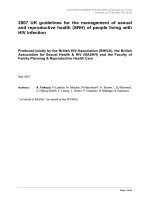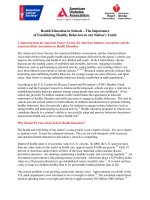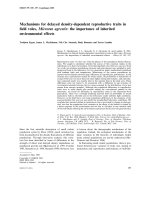Health Education in Schools – The Importance of Establishing Healthy Behaviors in our Nation’s Youth pptx
Bạn đang xem bản rút gọn của tài liệu. Xem và tải ngay bản đầy đủ của tài liệu tại đây (132.32 KB, 5 trang )
Health Education in Schools – The Importance of Establishing Healthy
Behaviors in our Nation’s Youth
A Statement from the American Cancer Society, the American Diabetes Association, and the
American Heart Association on Health Education
The American Cancer Society, the American Diabetes Association, and the American Heart
Association believe that quality health education programs delivered in the nation’s schools can
improve the well-being and health of our children and youth. In the United States, chronic
diseases are the leading causes of morbidity and mortality; however, engaging in healthy
behaviors, such as participating in physical activity, eating healthy, and avoiding tobacco use,
have been linked to prevention of chronic disease.
1,2,3,4,5
Research studies provide evidence that
promoting and establishing healthy behaviors for younger people are more effective, and often
easier, than efforts to change unhealthy behaviors already established in adult populations.
6
According to the U.S. Centers for Disease Control and Prevention’s (CDC) Healthy Youth
initiative and the Carnegie Council on Adolescent Development, schools can play a vital role in
establishing healthy behavior patterns among young people that carry into adulthood.
7
Every
school day provides 54 million students in the United States the opportunity to learn the
importance of healthy lifestyles and skills necessary to engage in healthy behaviors. Not only do
schools provide critical outlets to reach millions of children and adolescents to promote lifelong
healthy behaviors, they also provide a place for students to engage in these behaviors, such as
eating healthy and participating in physical activity.
8
Health education programs in schools can
contribute directly to a student’s ability to successfully adopt and practice behaviors that protect
and promote health and avoid or reduce health risk.
9
Why Should We Care About School Health Education?
The health and well-being of our nation’s young people is not a matter of luck. It is not a chance
or random event. It must be a planned outcome. The case for well-designed, well-resourced,
and sustained health education in the nation’s schools is compelling.
Improved health status is of economic value to U.S. citizens. In 2006, the U.S. spent far more
than any other nation in the world on health care, approximately $7,000 per person.
10
Only 18
percent of American adults follow all three of the most important cardiovascular disease
prevention measures: not smoking, maintaining a healthy weight, and exercising regularly.
11
An
investment in prevention is like putting money in the bank. Americans place a $10 trillion dollar
value on a 20 percent reduction in age standardized cancer mortality rates.
12
It is easier and less
costly to keep our children healthy than to fix preventable health problems later in life.
One critical problem is our growing, nationwide obesity crisis. Approximately two-thirds of the
U.S. adult population is now estimated to be overweight or obese.
13
The estimated annual direct
medical spending from overweight and obesity is approximately $92 billion (2002 dollars).
14
2
The number of obese Medicare beneficiaries nearly doubled from 1987 to 2002, and the
spending incurred by them almost tripled.
15
Overweight and obesity is also a crisis among
children. The number of overweight children aged 6-11 has tripled over the past three decades.
16
Approximately 17 percent of today’s youth are overweight.
17
The health effects of obesity are
devastating. For children born in 2000 in the U.S., if obesity rates remain unchanged, their
lifetime risk of being diagnosed with diabetes at some point in their lives is estimated at 30
percent for boys and 40 percent for girls.
18
Obesity also is a major contributor to heart disease,
arthritis, and some types of cancer. Annual deaths associated with obesity are estimated to be
between 100,000 and 300,000 in the U.S.
19
School health education programs can reduce health risk behaviors such as tobacco use, poor
nutrition, lack of physical activity, drug and alcohol use, as well as actions that increase stress,
and risk of injury, and violence. Because these behaviors are amenable to change, quality school
health education taught by trained and certified health educators provides the best opportunity to
promote positive health behavior among children and adolescents.
What is Quality School Health Education?
A comprehensive, quality school health education program should use the National Health
Education Standards to guide curriculum development.
20
The Standards focus on increasing
functional health knowledge and identifying key skills that are applicable to all aspects of
healthy living. These skills include identifying the influence of family, peers, culture, media,
and technology on health behavior; knowing how to access and use valid health information; and
using communication, decision-making, goal-setting, and advocacy skills to engage in health-
enhancing behaviors. Further, the effectiveness and quality of health education programs have
been linked to adequate instructional time devoted to health education in the classroom.
21
A strong relationship exists between school health education and health literacy.
22
Health
literacy is the capacity of individuals to obtain, interpret, and understand basic health information
and services in ways which are health enhancing. The development of health literacy is essential
for students to adopt and maintain healthy behaviors and have improved quality of life.
23
A 2004
report by the Institute of Medicine on health literacy states that “the most effective means to
improve health literacy is to ensure that education about health is part of the curriculum at all
levels of education.”
24
According to the World Health Organization (WHO), research has provided evidence that
effective school health programs are intense and begin prior to the onset of the risky behaviors;
and both primary and secondary schools should have a planned, sequenced curriculum.
25
Adequate instructional time is necessary for students to learn essential health education
knowledge and skills that are developmentally appropriate and build from year to year. The
Joint Committee on National Health Education Standards recommends that students in Pre-K to
grade 2 receive a minimum of 40 hours and students in grades 3 to 12 receive 80 hours of
instruction in health education per academic year.
26
In the WHO’s Information Series on School
Health, a decade of evaluation research indicates three important findings regarding quality
school health education programs
27
:
3
Health education that concentrates on developing health-related skills and imparting
health-related knowledge and attitudes is more likely to help youth practice health
enhancing behaviors.
Skill development is more likely to result in the desired healthy behavior when practicing
the skill is tied to the content of a specific health behavior or health decision.
The most effective method of skill development is learning by doing – involving students
in active, participatory experiences, rather than passive ones.
Why is School Health Education Important?
While approximately 90 percent of U.S. children are born healthy, the United States is ranked
last, out of 21 industrialized countries in overall child health and safety.
28
In addition, recent
statistics show that 1 in 5 high school students are current smokers; approximately 80 percent of
students do not eat the recommended 5 servings of vegetables and fruits per day; more than
830,000 adolescents become pregnant each year; and approximately 15 million school days are
missed due to uncontrolled asthma each year.
29
These statistics are alarming and disturbing for
the health of the nation.
The good news is that research has revealed that health risk behaviors that contribute to the
leading causes of death in the United States are often developed during childhood and prevention
is the best cure for chronic disease. School health education provides the fundamental basis for
instilling behaviors into our young people to prevent or delay the onset of the leading causes of
death in our country.
30
New evaluation of health education research shows promise of having a positive impact on
academic achievement as it has on health outcomes. Well-designed, well-delivered school-based
health interventions can enable students to prevent disease and injury.
31,32,33
The ACS, ADA and
AHA believe that health education is a critical component of effective school health
interventions
Collective Responsibility to Address Quality and Quantity of School Health Education
The American Cancer Society, the American Diabetes Association, and the American Heart
Association encourage quality school health education within all schools in the United States
through the use of strategies such as:
Utilizing school health education programs that adhere to the recommendations from the
National Health Education Standards.
Employing highly qualified and effective health educators.
Ensuring recommended health education instruction time at the elementary and
secondary levels.
Having a national plan and budget to support school health education.
In conclusion, the potential for school health education to improve health and save lives is
significant. If we as a nation want to keep children and adolescents healthy, it is important to
find better ways to provide quality school health education.
4
1
Centers for Disease Control and Prevention (CDC). Increasing Physical Activity: A Report on Recommendations
of the Task Force on Community Preventive Services. MMWR 2001; 50(No. RR-18).
2
U.S. Department of Health and Human Services. Reducing the health consequences of smoking: 25 years of
progress; a report of the Surgeon General. Rockville, MD: U.S. Department of Health and Human Services, CDC,
Office of Smoking and Health; 1989. DHHS Publication No. (CDC) 89-8411.
3
National Institute on Alcohol Abuse and Alcoholism. Tenth Special Report to the U.S. Congress on Alcohol and
Health. Bethesda, MD: National Institute on Alcohol Abuse and Alcoholism; 2000.
4
National Heart, Lung, and Blood Institute. Clinical Guidelines on Identification, Evaluation and Treatment of
Overweight and Obesity in Adults. Bethesda, MD: National Institutes of Health, National; Heart, Lung, and Blood
Institute; 1998. NIH Publication No. 98-4083.
5
CDC. Surveillance for Asthma – United States, 1980-1999. In: CDC Surveillance Summaries, March 29, 2002.
MMWR 2000; 51(No. SS-1).
6
U.S. Department of Health and Human Services. Healthy Youth: An Investment in Our Nation’s Future, 2007.
Atlanta, GA: U.S. Department of Health and Human Services, CDC, Coordinating Center for Health Promotion;
2007. Retrieved June 3, 2007 from
7
U.S. Department of Health and Human Services. Healthy Youth: An Investment in Our Nation’s Future, 2007.
Atlanta, GA: U.S. Department of Health and Human Services, CDC, Coordinating Center for Health Promotion;
2007. Retrieved June 3, 2007 from
8
U.S. Department of Health and Human Services. Healthy Youth: An Investment in Our Nation’s Future, 2007.
Atlanta, GA: U.S. Department of Health and Human Services, CDC, Coordinating Center for Health Promotion;
2007. Retrieved June 3, 2007 from
9
Joint Committee on National Health Standards. National Health Education Standards: Achieving Excellence.
American Cancer Society; 2007.
10
Centers for Medicare & Medicaid Services, Office of the Actuary, National Health Statistics Group; U.S.
Department of Commerce, Bureau of Economic Analysis; and U.S. Bureau of the Census.
11
Soni A. Personal health behaviors for heart disease prevention among the U.S. adult civilian non-institutionalized
population, 2004. Statistical Brief #165. March 2007. Agency for Healthcare Research and Quality.
12
Murphy KM, Topel, RH. The Economic Value of Medical Research, 1999.
13
Ogden CL, Carroll MD, Curtin LR, McDowell MA, Tabak CJ, Flegal KM. Prevalence of overweight and obesity
in the United States, 1999-2004. JAMA 295: 1549-1555.
14
Finkelstein EA, Fiebelkorn IA, Wang G. National Medical Spending Attributable to Overweight and Obesity:
How Much, and Who’s Paying. Health Affairs – Web Exclusive. May 14, 2003; w3-219 – w3-226.
15
Thorpe KE, Howard DH. The Rise of Medicare Beneficiaries: The Role of Chronic Disease Prevalence and
Changes in Treatment Intensity. Health Affairs. Sept/Oct 2006; 25(5): w378-w388.
16
CDC. National Center for Health Statistics. NHANES data retrieved January 30, 2008 from
17
Ogden CL, Carroll MD, Curtin LR, McDowell MA, Tabak CJ, Flegal KM. Prevalence of overweight and obesity
in the United States, 1999-2004. JAMA 295: 1549-1555.
18
Narayan KM, Boyle JP, Thompson TJ, Sorenson SW, Williamson DF. 2003. Lifetime risk for diabetes mellitus
in the United States. JAMA 290 (14): 1884-1890.
19
Flegal KM, Graubard BI, Williamson DF, Gail MH. Excess deaths associated with underweight, overweight, and
obesity. JAMA. 2005; 293: 1861-1867. Mokdad AH, Marks JS, Stroup DF, Gerberding, JL. Actual causes of
death in the United States, 2000. JAMA. 2004, 291: 1238-1245. [CDC recalculated its 2004 estimate in 2005.
While the 2004 estimate is believed to be an overestimate, the 2005 is believed to be an underestimate and so a
range is presented. Regardless the number of deaths attributable to obesity are extraordinarily high.]
20
Joint Committee on National Health Standards. National Health Education Standards: Achieving Excellence.
American Cancer Society; 2007.
21
Joint Committee on National Health Standards. National Health Education Standards: Achieving Excellence.
American Cancer Society; 2007.
22
Joint Committee on National Health Education Standards. (1995). Achieving health literacy: An investment in the
future. Atlanta, GA: American Cancer Society.
23
Joint Committee on National Health Education Standards. (1995). Achieving health literacy: An investment in the
future. Atlanta, GA: American Cancer Society.
5
24
Allensworth D, Wyche J, Lawson E, Nicholson L eds. Committee on Comprehensive School Health Programs,
Division of Health Science Policy, Institute of Medicine. Defining a comprehensive school health program: An
interim statement; 1995. National Academy Press: Washington, D.C.
25
World Health Organization. Information series on school health: Skills for health; 2003. Retrieved June 3, 2007
from
26
Joint Committee on National Health Standards. National health education standards: Achieving excellence.
American Cancer Society; 2007.
27
World Health Organization. Information series on school health: Skills for health; 2003. Retrieved June 3, 2007
from
28
UNICEF. Child poverty in perspective: An overview of child well-being in rich countries: A comprehensive
assessment of the lives and well-being of children and adolescents in economically advanced nations; 2007.
Retrieved June 3, 2007 from
29
U.S. Department of Health and Human Services. Healthy Youth: An Investment in Our Nation’s Future, 2007.
Atlanta, GA: U.S. Department of Health and Human Services, CDC, Coordinating Center for Health Promotion;
2007. Retrieved June 3, 2007 from
30
U.S. Department of Health and Human Services. Healthy Youth: An Investment in Our Nation’s Future, 2007.
Atlanta, GA: U.S. Department of Health and Human Services, CDC, Coordinating Center for Health Promotion;
2007. Retrieved June 3, 2007 from
31
Botvin GJ, Baker E, Dusenbury L, Botvin EM, Diaz T. Long-term follow-up results of a randomized drug abuse
prevention trial in a white middle-class population. JAMA 1995;273(14):1106-12.
32
Gortmaker SL, Peterson RD, Wiecha J, Sobol AM, Dixit S, Fox MK, Laird N Reducing obesity via a school-
based interdisciplinary intervention among youth. Archives of Pediatric and Adolescent Medicine 1999;153:409-
418. (CDC) 89-8411.
33
Centers for Disease Control and Prevention (CDC). Increasing Physical Activity: A Report on Recommendations
of the Task Force on Community Preventive Services. MMWR 2001; 50(No. RR-18): 1-14









